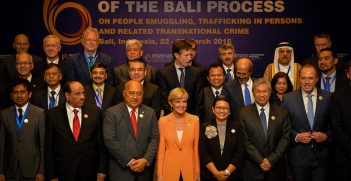Confidence Building in the South China Sea

The sixth International Workshop on the South China Sea provided new insights into confidence building measures that may influence the nature of the dispute.
The sixth International Workshop on the South China Sea held in Da Nang, Vietnam captured the special attention of policy makers, business sectors, media and citizens within and outside the region. Run under the auspices of the Diplomatic Academy of Vietnam (DAV), Vietnamese Lawyers’ Association (VLA) and the Foundation for East Sea Studies (FESS), the workshop resonated internationally. As one scholar remarked, the South China Sea disputes are now global issues, not regional ones, given their far-reaching geostrategic, geopolitical, economic, commercial, and environmental implications.
Confidence building as an attempt to remedy the escalating distrust
This year’s international workshop was the sixth in a series of stimulating efforts by the DAV and VLA (supported by the Vietnamese government) to nurture awareness and enlist support from the international community in their collective endeavour to deactivate explosive hotspots for the sake of regional security and development. However, tensions about countries’ unilateral and uncooperative behaviour arose across myriad areas including: freedom of navigation in the disputed seas, the reclamation of rocks, fish bans imposed on foreign ships, the redrawing of maps, China’s declaration of an Air Defense Identification Zone (ADIZ) without consulting its neighbours, and the latest stand-off about the CNOOC (HYSY)-981 in Vietnam’s EEZ. These pose serious challenges to the peaceful resolution of the dispute in the South China Sea.
Confidence starts from cooperation and transparency
Confidence building measures refer to cooperation in various fields including: the clarification of claims, restraint from the use of force, unilateral or disruptive behaviour, and an inclination to use non-violent measures such as functional cooperation and negotiation. Out of all of these measures, the clarification of claims in maritime areas in the disputed sea is of the utmost significance. This is because the existence of too many ‘grey areas’ may prevent further substantial cooperation, and could be very costly to a fragile status quo that is vulnerable to reversal. For example, it is noteworthy that, in his speech at the recent exhibition ceremony held in Taipei, Taiwanese President Ma Ying Jeou touched upon the nine-dotted (U-shaped) line drawn by the Kuomintang Government in 1947 and endorsed by Taipei and Beijing. President Ma clarified Taiwan’s position, declaring that the Kuomintang claim only mentioned the islands, not the maritime areas, which fell within this line. While President Ma did not further challenge the validity of the U-shaped line, since this could shatter his merits in cross-strait relations with China, his initial departure from the shared position with Beijing provides a good example of how claimants can address obstacles through compromise and cooperation.
Cooperation as mutual compromise
If China remains ambiguous over the nine-dotted line in the position paper circulated among UN member states, which promises Beijing up to 90 percent of the South China Sea, the country will obstruct steps toward genuine trust and true cooperation in the contested area. Even if the line is proven true historically, with the rock features belonging to China, these islands (which can generate territorial sea, contiguous shelf and EEZ under the UN Convention on the Law of the Sea stating “the land dominates the sea”) will be subject to painstaking demarcation and the convention’s strict definition about island status when it comes to overlapping claims. In other words, Chinese leaders’ repeated declarations of turning the South China Sea into “a sea of peace and cooperation’” must be matched by a flexible approach that recognises and respects UN conventions.
Buying time: too costly for China’s ‘dream’ future
Undoubtedly, China has the most developed strategy and capability to undermine other states’ maritime activities in the disputed sea. However, how can one can justify or legitimise their behaviour as right or wrong, good or bad? Professor Carl Thayer suggests that China’s behaviour should be placed in light of a self-other relationship, since judgment is both an action and a reaction from the outside and within. To put it simply, it is not only the Chinese government and their people (self) who can legitimise their behaviour, but it is also the rest of the world (other) who can characterise China’s unilateral acts in solving the hotspot as either virtuous or adversarial. Governments and people in claimant states are expecting China to act as a responsible great power, rather than asserting that the time is not “appropriate”. China must learn to adapt its approach to foreign policy in its transformation into a world power.
It is only when Beijing takes out the historical nine-dotted line as a prerequisite in its negotiations with other claimants, and gradually learns to listen and to respect their claims, can confidence building measures contribute to sustainable peace and security. Otherwise, such measures are reduced to time-buying strategies by individual state(s) at the expense of regional peace and prosperity. In a nutshell, short-term gains would eventually cost Beijing’s long-term “dream” of re-ascendancy to world power status.
Julia Luong Dinh is a PhD student at the University of Sydney. This article can be republished with attribution under a Creative Commons Licence.





